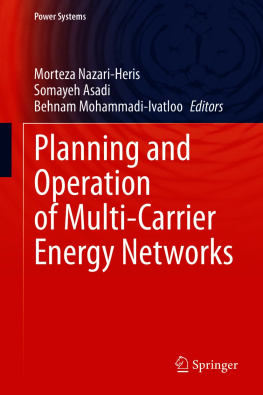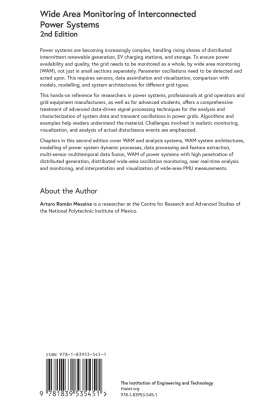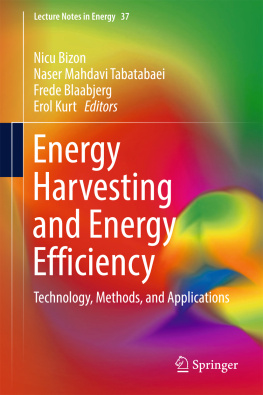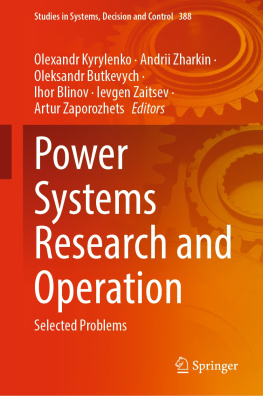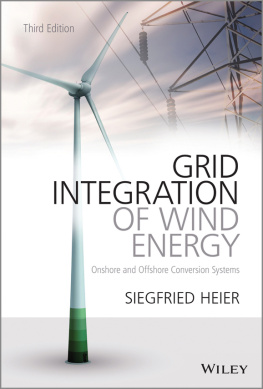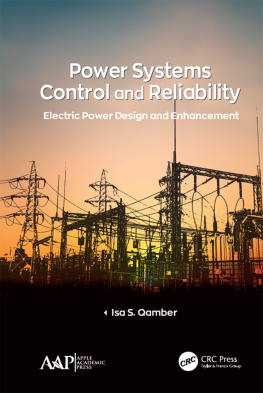Power Systems
Electrical power has been the technological foundation of industrial societies for many years. Although the systems designed to provide and apply electrical energy have reached a high degree of maturity, unforeseen problems are constantly encountered, necessitating the design of more efficient and reliable systems based on novel technologies. The book series Power Systems is aimed at providing detailed, accurate and sound technical information about these new developments in electrical power engineering. It includes topics on power generation, storage and transmission as well as electrical machines. The monographs and advanced textbooks in this series address researchers, lecturers, industrial engineers and senior students in electrical engineering.
**Power Systems is indexed in Scopus**
More information about this series at http://www.springer.com/series/4622
Editors
Morteza Nazari-Heris
Department of Architectural Engineering, Pennsylvania State University, University Park, PA, USA
Somayeh Asadi
Department of Architectural Engineering, Pennsylvania State University, University Park, PA, USA
Behnam Mohammadi-Ivatloo
Faculty of Electrical and Computer Engineering, University of Tabriz, Tabriz, Iran
Department of Energy Technology, Aalborg University, Aalborg East, Denmark
ISSN 1612-1287 e-ISSN 1860-4676
Power Systems
ISBN 978-3-030-60085-3 e-ISBN 978-3-030-60086-0
https://doi.org/10.1007/978-3-030-60086-0
Springer Nature Switzerland AG 2021
This work is subject to copyright. All rights are reserved by the Publisher, whether the whole or part of the material is concerned, specifically the rights of translation, reprinting, reuse of illustrations, recitation, broadcasting, reproduction on microfilms or in any other physical way, and transmission or information storage and retrieval, electronic adaptation, computer software, or by similar or dissimilar methodology now known or hereafter developed.
The use of general descriptive names, registered names, trademarks, service marks, etc. in this publication does not imply, even in the absence of a specific statement, that such names are exempt from the relevant protective laws and regulations and therefore free for general use.
The publisher, the authors and the editors are safe to assume that the advice and information in this book are believed to be true and accurate at the date of publication. Neither the publisher nor the authors or the editors give a warranty, expressed or implied, with respect to the material contained herein or for any errors or omissions that may have been made. The publisher remains neutral with regard to jurisdictional claims in published maps and institutional affiliations.
This Springer imprint is published by the registered company Springer Nature Switzerland AG
The registered company address is: Gewerbestrasse 11, 6330 Cham, Switzerland
Preface
Nowadays, the high integration rate of interconnecting energy technologies in energy systems has been increased, such as combined heat and power plants, natural gas-fired power plants, power to gas technology, hydropower plants, and water desalination systems. Accordingly, the design and operation of multi-carrier networks should be studied, taking into account the operational and technical constraints of each interconnecting element between energy systems and the network constraints of each energy system. Hence, studying the optimal design and operation of multi-carrier energy networks associated with different kinds of energy carriers such as gas, power, heating, cooling, and water carriers is of great importance for attaining more effective and promising operation of such networks, and has received significant attention of researchers. The operation of multi-carrier energy networks considering various interconnecting elements is improved in different studies regarding economic and environmental viewpoints. The consideration of interconnecting elements in the operation of multi-carrier energy networks is a realistic framework since the constraints of all of the energy networks as well as the interconnecting elements are considered in the operation and design of such systems. Also, the multi-carrier energy storage facilities such as the power to gas systems and pumped storage technology are effective in improving the operation of multi-carrier energy systems because one form of energy can be converted to another form when the load demand is low, and it can be used in supplying the load demand of an energy carrier in on-peak hours. The book Planning and Operation of Multi-Carrier Energy Networks aims to discuss the recent developments and contribution of optimal design and operation of multi-carrier energy networks in both aspects of providing a comprehensive review on the title and proposing new models of operation and design of such systems.
The book covers theoretical background and experimental analysis of the multi-carrier energy networks with concentrations on gas, power, heating, cooling, and water carrier, special and professional fields of integrated energy systems. The authors focus on the optimal design and operation of multi-carrier energy systems. Thus, the studied challenging issues in this book can provide effective and promising solutions for the optimal design and operation of energy systems. The authors try to study the optimal design and operation of multi-carrier energy networks with concentrations on the integration of various energy carriers as well as interconnecting elements between such systems. The application and study cases are selected, with as many realistic cases around the world are investigated. The authors hope the current book helps undergraduate and graduate students, researchers, and engineers, trying to evaluate the concept of multi-carrier energy networks based on theoretical aspects and application case studies. The topics covered in this book are presented in the following:
Overview on the operation of multi-carrier energy networks
The role of demand response programs and energy storage facilities in optimal operation of multi-carrier energy networks
Operation of multi-carrier energy networks by modeling the uncertain parameters
Introduction to planning and sizing of multi-carrier energy networks
Network expansion planning of multi-carrier energy systems by modeling the uncertain parameters
Risk-constrained planning of multi-carrier energy systems

